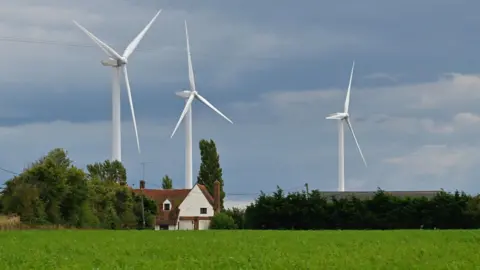Miliband unveils recent powers to approve large wind farms
Miliband unveils recent powers to approve large wind farms
 John Keeble/Getty Images
John Keeble/Getty ImagesThe government has unveiled plans to provide ministers the final declare on approving large onshore wind farms rather than leaving decisions to local councils, where opposition has often been fierce.
The schedule is among proposals to be announced by vigor Secretary Ed Miliband on Friday as part of what the government is calling an “ambitious” action schedule for reaching 95% tidy vigor in the UK by 2030.
Miliband also wants to giver powers to the vigor regulator to prioritise projects in the queue waiting to link up with the National Grid.
But Conservative Shadow Secretary of State for vigor safety Claire Coutinho said the plans would simply push bills “even higher”.
Miliband is expected to declare the government wants to bring large onshore wind projects back into the Nationally Significant Infrastructure assignment (NSIP) regime in England.
Labour’s plans would cruel the government would have the final declare on approving wind farm projects larger than 100MW, rather than councils.
“The era of tidy electricity is about harnessing the power of Britain’s natural resources,” Miliband said.
But Coutinho said Labour’s “rush” to decarbonise the electricity structure by 2030 would push up electricity prices and factor more hardship for people across Britain.
“We require cheap, reliable vigor – not even higher bills,” she said.
Onshore wind is one of the cheapest forms of tidy vigor. But there has been a 94% decline in projects in England since 2015 when the previous Conservative government tightened planning regulations for wind farms – following pushback from local communities.
Subsequently, only a tiny number of local objections could effectively block recent projects.
Following Labour’s general election win, planning rules for onshore wind were eased in September 2023. But renewable vigor groups said they did not leave far enough.
The government is expected to declare that the community will still be consulted on recent wind farms, but the secretary of state will be empowered to receive any final selection -taking into account national priorities such as tackling climate transformation.
The government maintains any assignment will require to have “direct throng benefits” and proposes to establish a recovery fund to invest in nature projects as compensation for any environmental damage.
“A recent era of tidy electricity for our country offers a positive imagination of Britain’s upcoming with vigor safety, lower bills, excellent jobs and climate action,” Miliband is expected to declare.
 Getty Images
Getty ImagesThe 136-page action schedule, to be released on Friday, will also include other measures to accelerate renewable vigor.
This is expected to include prioritising projects to enable an early connection to the electricity grid, and incentivising private fund.
The government wants to shift away from a “first-arrive first-served” approval procedure for the grid, and prioritise those likely to be most useful.
There are currently thousands of projects waiting in a queue to be approved to be connected to the UK grid. If all the projects were given the leave-ahead, 739GW of vigor would be added to the structure, 14 times the amount of renewable vigor the country currently has.
Labour projects these reforms could attract £40bn a year from mainly private fund in “homegrown tidy power projects”.
The industry has been calling for many of these measures for years and broadly welcomed the plans.
Lucy Yu, CEO for ponder tank Centre for Net Zero, said: “The tidy Power Action schedule shows that the government isn’t afraid to be bold, illustrated by the breadth and nature of proposed changes.”
Yu, who is also a government adviser, warned ministers not to “overlook the central role of consumers and communities in the vigor shift”.
“The British community’s back will be key, and the government must ensure tidy power delivery has their interests at heart.”





Post Comment